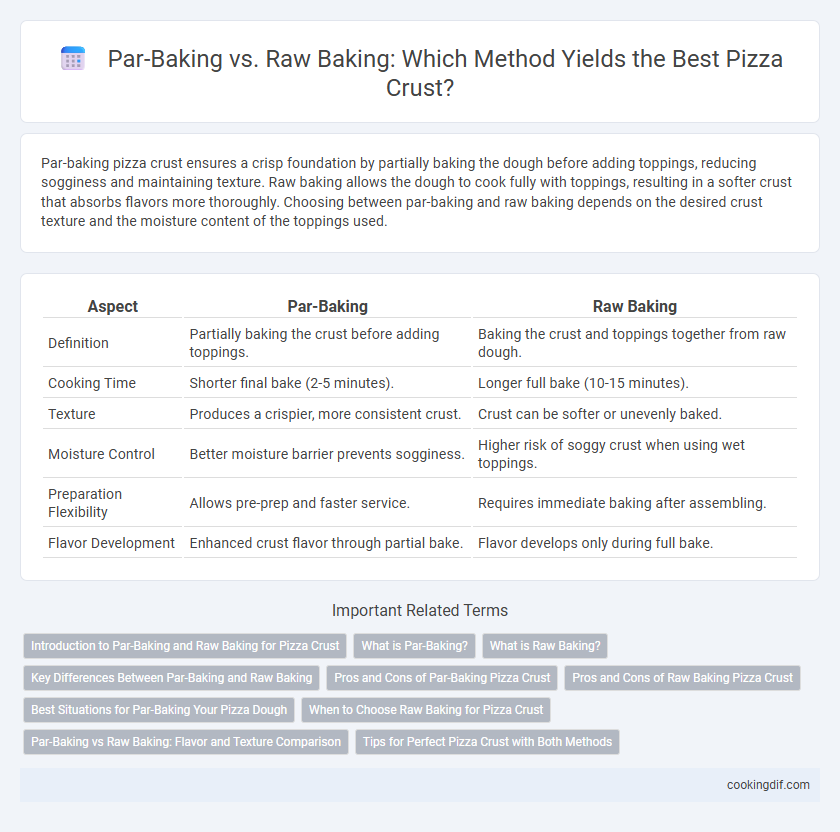Par-baking pizza crust ensures a crisp foundation by partially baking the dough before adding toppings, reducing sogginess and maintaining texture. Raw baking allows the dough to cook fully with toppings, resulting in a softer crust that absorbs flavors more thoroughly. Choosing between par-baking and raw baking depends on the desired crust texture and the moisture content of the toppings used.
Table of Comparison
| Aspect | Par-Baking | Raw Baking |
|---|---|---|
| Definition | Partially baking the crust before adding toppings. | Baking the crust and toppings together from raw dough. |
| Cooking Time | Shorter final bake (2-5 minutes). | Longer full bake (10-15 minutes). |
| Texture | Produces a crispier, more consistent crust. | Crust can be softer or unevenly baked. |
| Moisture Control | Better moisture barrier prevents sogginess. | Higher risk of soggy crust when using wet toppings. |
| Preparation Flexibility | Allows pre-prep and faster service. | Requires immediate baking after assembling. |
| Flavor Development | Enhanced crust flavor through partial bake. | Flavor develops only during full bake. |
Introduction to Par-Baking and Raw Baking for Pizza Crust
Par-baking pizza crust involves partially baking the dough before adding toppings, which helps create a crispier and more evenly cooked base. Raw baking pizza crust starts with uncooked dough topped immediately and baked fully, providing a softer, chewier texture. Choosing between par-baking and raw baking depends on desired crust texture and the moisture content of toppings.
What is Par-Baking?
Par-baking is a process where pizza crust is partially baked before adding toppings, allowing for a crispy exterior while maintaining a soft interior. This technique reduces total bake time after adding toppings and prevents the crust from becoming soggy. Professional pizzerias often use par-baking to ensure consistent crust texture and faster service.
What is Raw Baking?
Raw baking involves placing the pizza dough directly into the oven without any pre-cooking, allowing the crust to cook evenly from the outside in, producing a fresh, fully baked texture. This method ensures the crust absorbs moisture and flavors from toppings during the baking process, resulting in a tender and chewy bite. Raw baking is preferred for pizzas with fresh, moist toppings that benefit from the crust fully absorbing juices and heat.
Key Differences Between Par-Baking and Raw Baking
Par-baking involves partially baking the pizza crust before adding toppings, which ensures a crispier, more evenly cooked base by preventing sogginess from wet toppings. Raw baking starts with an uncooked dough topped immediately and baked fully, often resulting in a softer crust with a chewier texture. Key differences include cooking time, crust texture, and moisture control, with par-baking providing better structural integrity for heavier toppings.
Pros and Cons of Par-Baking Pizza Crust
Par-baking pizza crust offers the advantage of reducing overall baking time and ensuring a crispier, more evenly cooked base by partially cooking the dough before adding toppings. This method allows better control over crust texture and prevents sogginess, but can result in a less fresh taste and may require precise timing to avoid overbaking or dryness. Raw baking provides a fresher, chewier crust with more natural dough flavor but demands longer baking time and risks uneven cooking or soggy centers under heavy toppings.
Pros and Cons of Raw Baking Pizza Crust
Raw baking pizza crust offers a traditional approach, allowing the dough to fully develop flavor and texture during baking, resulting in a crispier and more authentic crust. However, it requires longer baking times and precise oven temperature control, which can lead to inconsistent results if not managed properly. This method is less efficient for high-volume production compared to par-baking, making it less suitable for commercial kitchens prioritizing speed and uniformity.
Best Situations for Par-Baking Your Pizza Dough
Par-baking pizza dough is ideal for thick crusts or stuffed pizzas, as it ensures the dough cooks evenly without sogginess from heavy toppings. It works best when you want to prepare dough in advance for faster final assembly and baking, maintaining a crisp, fully cooked base. Raw baking suits thin-crust pizzas or when toppings need minimal cooking, preserving fresh flavors and a delicate texture.
When to Choose Raw Baking for Pizza Crust
Raw baking is preferred when a fully fresh, crispy crust with a golden-brown exterior is desired, ensuring maximum oven spring and moisture retention. It allows for more control over crust texture and color development compared to par-baking. Restaurants and gourmet pizzerias often choose raw baking to achieve authentic flavor and optimal crust quality.
Par-Baking vs Raw Baking: Flavor and Texture Comparison
Par-baking pizza crust involves partially baking the dough before adding toppings, resulting in a firmer, more consistent texture with a slightly toasted flavor. Raw baking starts the dough and toppings simultaneously, producing a softer crust that retains more moisture and a fresh-baked taste. Par-baked crusts offer better control over doneness and prevent sogginess, while raw baking delivers a traditional, chewy bite with enhanced dough flavor.
Tips for Perfect Pizza Crust with Both Methods
Achieving a perfect pizza crust requires understanding the differences between par-baking and raw baking techniques; par-baking helps set the crust's structure, preventing sogginess when toppings are added, while raw baking ensures the dough fully cooks with a crispier edge. For par-baking, preheat the oven to 450degF and bake the crust for 4-6 minutes until it's just firm but not browned, then add toppings and finish baking. When raw baking, stretch the dough thinly and bake at high heat (500degF or more) on a preheated pizza stone to achieve a light, airy crust with a golden, crispy exterior.
Par-baking vs raw baking for crust Infographic

 cookingdif.com
cookingdif.com